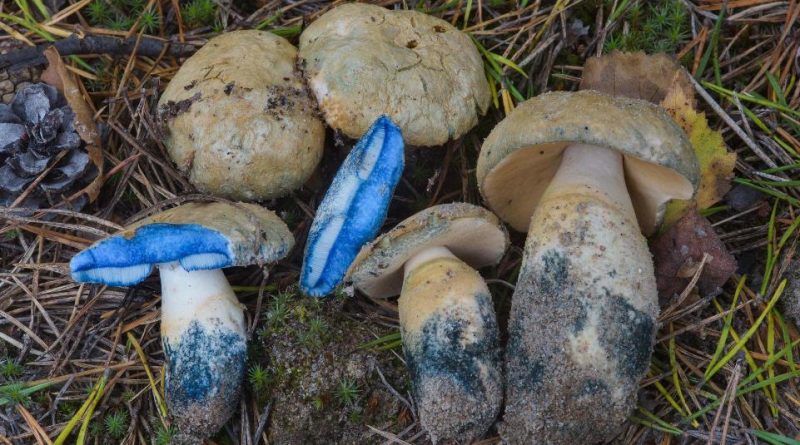Gyroporus cyanescens
Gyroporus cyanescens
The blue Boleto or Boleto cornflower (Gyroporus cyanescens (Bull.) Quél., 1886) is a basidiomycete mushroom of the Gyroporaceae family.
Systematics –
From the systematic point of view it belongs to the Eukaryota Domain, Kingdom Fungi, Basidiomycota Division, Basidiomycetes Class, Order Boletales, Family Gyroporaceae and then to the Gyroporus Genus and to the G. cyanescens Species.
The term Boletus cyanescens Bull is synonymous. ex Fr ..
Etymology –
The term Gyroporus comes from the Greek γῦρος gýros circle, circle and from πόρος póros poro, passage: because of the round pores. The specific epithet cyanescens for the toning of the flesh to an intense blue color just touched.
Geographic Distribution and Habitat –
Gyroporus cyanescens is a fungus that fructifies in the period between summer and autumn; it is found solitary or gregarious, especially in broad-leaved woods and in open and dry places.
Recognition –
The blue Boleto is recognized for the hat of 5-15 cm in diameter, first hemispheric then smoothed, irregular, fleshy, with cuticle dry even with moisture, soft, velvety with hairs and bows darker than the bottom that varies from whitish to yellowish with ocher or oliveal reflections. The hymenophore is characterized by whitish and then yellowish tubules, not adherent to the stem, on average high up to 1.5 cm. The pores are small, round, whitish then yellowish, which quickly turn to the indigo blue if rubbed. The stem is 5-10 cm in height, 1.5-3 cm thick, robust, cylindrical and thickened at the base, hard, fragile, full but soon cavernous and finally hollow. The meat is massive, of firm consistency that of the hat, first spongy and then the shank of the stem, in which at maturity remains almost only the bark. This has the characteristic of rapidly turning to blue in the air, especially in damp weather; subsequently it decolorizes and returns to the gray-whitish; has a soft and pleasant smell, pleasant taste with a light salty sensation. The microscope shows spores of 8-10 x 4-8 μm, yellow in mass, ellipsoidal, hyaline.
Cultivation –
Gyroporus cyanescens is not a cultivated fungus.
Uses and Traditions –
The blue Boleto or Boleto cornflower owes its name as it is distinguished from other similar species by the intense color change to blue as soon as it is touched. It is in fact easily recognizable, even by a beginner, for the mere fact that in collecting it, it immediately stains blue more intensely as the air is humid. This particular allows us to distinguish it from other species of the same genus. It is a species that is not everywhere widespread, sufficiently circumscribed and can be found in just a few areas, even if in the latter it is present in a constant and abundant way. The violent toning of the indigo in the immediacy of the bruise or of the cut tends over time to regress into a dim gray.
There is also a form of this mushroom, Gyroporus cyanescens fo. lacteus (Lév.) Quél., white in color and a variety, the greenish-yellow Gyroporus cyanescens var.sulphureus Kalamees, found in the Mediterranean area under the Holm oaks.
Species similar to the Blue Boletus are: the Gyroporus castaneus (Bull .: Fries) Quél. from the unchanging flesh; the Boletus pulverulentus Opatowski, with strongly turning blue flesh with very dark hat, green pores and reddish-brown stem; the Caloboletus radicans (Pers .: Fr.) Vizzini = Boletus radicans (Pers.) Fr., whitish and with strongly amarescent flesh and, finally, the Gyroporus ammophilus (M.L. Castro & L. Freire) M.L. Castro & L. Freire, which grows in the coastal sabulicolous environment, practically implies Gyroporus castaneus (Bull .: Fries) Quél., Which, unlike all the above mentioned Gyroporus, is responsible for intoxication phenomena with gastrointestinal effects.
Gyroporus cyanescens is a fungus with fair edibility whose stem should be discarded in adult specimens because it is fibrous. However, it is of slightly lower quality than the congener Gyroporus castaneus.
Preparation Mode –
The Blue Boleto can be prepared especially when young and discarding the stem. As an adult, the meat becomes too spongy. Note that during cooking the bluish pulp disappears due to the gyrocyanin pigment. To be cooked or stored it must be cleaned well, because its pores are usually filled with sand from the wooded areas.
Guido Bissanti
Sources
– Wikipedia, the free encyclopedia.
– Cetto B., 2008. Real mushrooms, Saturnia, Trento.
– Pignatti S., 1982. Flora of Italy, Edagricole, Bologna.
– Conti F., Abbate G., Alessandrini A., Blasi C. (edited by), 2005. An annotated checklist of the Italian vascular flora, Palombi Editore.
Warning: Pharmaceutical applications and alimurgical uses are indicated for informational purposes only and do not in any way represent a medical prescription; there is therefore no liability for their use for curative, aesthetic or food purposes.


